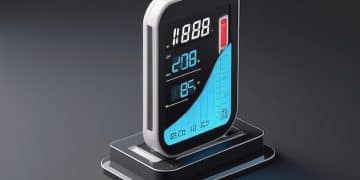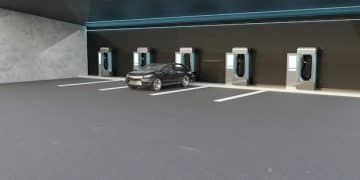Electric Vehicle Charging Breakthrough: 15-Minute Charge for Most EVs
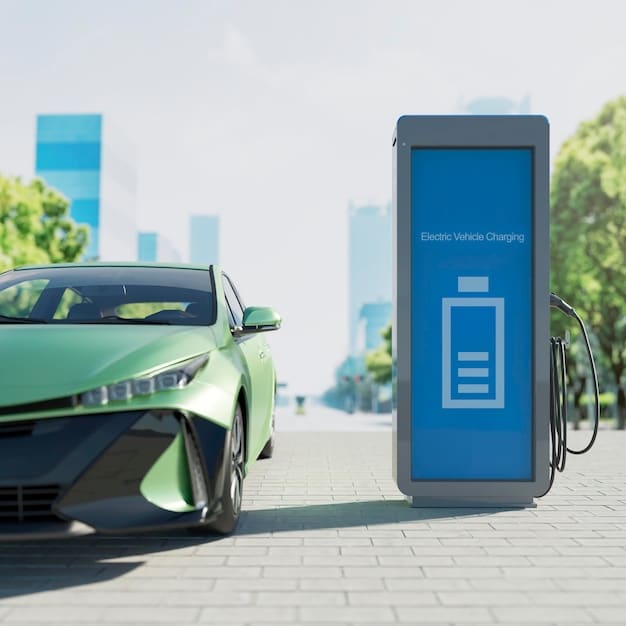
Electric Vehicle Charging Time Breakthrough: New Fast-Charging Technology Reduces Charging Time to 15 Minutes for Most Electric Vehicle Models, offering a significant leap forward in EV convenience and accessibility, potentially revolutionizing the adoption of electric vehicles.
The electric vehicle landscape is about to change dramatically. A new Electric Vehicle Charging Time Breakthrough: New Fast-Charging Technology Reduces Charging Time to 15 Minutes for Most Electric Vehicle Models promises to eliminate one of the biggest barriers to EV adoption: long charging times.
The Dawn of Ultra-Fast EV Charging
For years, the lengthy charging times associated with electric vehicles have been a significant hurdle for potential buyers. However, recent advancements in charging technology are paving the way for a new era of ultra-fast charging. This innovation not only enhances the convenience of owning an EV but also makes electric vehicles a more practical option for a wider range of consumers.
Understanding the Current Charging Landscape
Currently, EV charging speeds vary significantly depending on the charging level and the capabilities of the vehicle. Level 1 charging, which uses a standard household outlet, can take upwards of 24 hours to fully charge an EV. Level 2 charging, typically found at homes and public charging stations, reduces charging time to several hours. DC fast charging, the fastest available option, can provide a significant charge in a shorter time frame, but it still typically takes 30 minutes to an hour.
The Promise of 15-Minute Charging
The advent of Electric Vehicle Charging Time Breakthrough: New Fast-Charging Technology Reduces Charging Time to 15 Minutes for Most Electric Vehicle Models is a game-changer. This technology has the potential to bring EV charging times in line with the refueling experience of gasoline vehicles, dramatically improving the convenience and appeal of electric cars. Shorter charging times could alleviate range anxiety, encourage more frequent use of public charging stations, and accelerate the transition to electric mobility.
- Increased Convenience: Reduces charging times to match refueling times for traditional vehicles.
- Alleviated Range Anxiety: Makes long-distance travel in EVs more feasible and less stressful.
- Wider Consumer Appeal: Attracts a broader range of consumers who value speed and convenience.
In conclusion, ultra-fast EV charging represents a significant step forward in the development of electric vehicles. By addressing the issue of long charging times, this technology has the potential to transform the EV market and drive wider adoption of electric mobility.
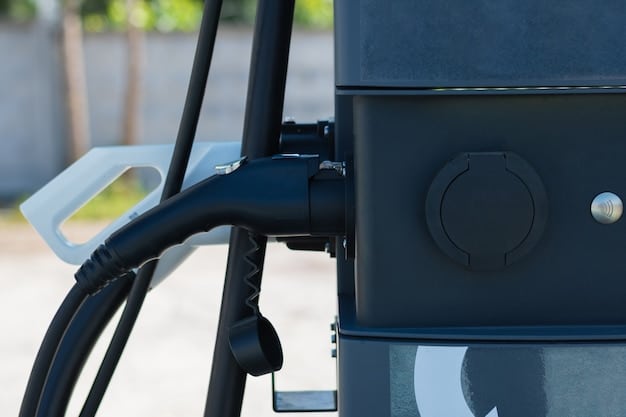
The Technology Behind the Breakthrough
The remarkable reduction in charging time is not a mere incremental improvement; it’s the result of innovative breakthroughs in several key areas. These include advancements in battery technology, charging infrastructure, and thermal management systems, all working in concert to deliver unprecedented charging speeds.
Advanced Battery Technology
One of the primary drivers of this breakthrough is the development of advanced battery chemistries capable of handling higher charging currents without compromising battery life or safety. Solid-state batteries and lithium-ion batteries with improved electrode materials are at the forefront of this innovation. These batteries are designed to accept and deliver energy at much faster rates, allowing for significantly reduced charging times.
Charging Infrastructure Innovation
Complementing the advancements in battery technology is the development of more powerful and efficient charging infrastructure. Next-generation charging stations are capable of delivering significantly higher levels of power, enabling faster charging speeds. These stations also incorporate smart charging algorithms that optimize the charging process based on the battery’s state of charge, temperature, and other factors, ensuring efficient and safe charging.
Enhanced Thermal Management
The rapid charging of batteries generates significant heat, which can degrade battery performance and lifespan. To address this challenge, innovative thermal management systems have been developed to effectively dissipate heat during the charging process. Liquid cooling systems and advanced heat sinks are used to maintain optimal battery temperatures, allowing for faster charging without compromising battery health.
In summary, the Electric Vehicle Charging Time Breakthrough: New Fast-Charging Technology Reduces Charging Time to 15 Minutes for Most Electric Vehicle Models is powered by a combination of advanced battery technology, innovative charging infrastructure, and enhanced thermal management systems. These technologies enable EVs to charge at unprecedented speeds, making electric mobility more convenient and accessible.
Impact on Electric Vehicle Adoption
The introduction of 15-minute charging technology is poised to have a transformative impact on the adoption of electric vehicles. By addressing one of the key barriers to EV ownership, this technology has the potential to accelerate the transition to electric mobility and drive wider consumer acceptance.
Addressing Range Anxiety
Range anxiety, the fear of running out of charge while driving, has long been a concern for potential EV buyers. The availability of 15-minute charging can alleviate this concern by making it easier and faster to recharge on the go. With charging times comparable to refueling a gasoline car, drivers can feel more confident about undertaking long journeys in their EVs.
Enhancing Convenience
The convenience of 15-minute charging can also make EVs a more attractive option for urban dwellers and those with limited access to home charging. With quick charging stations readily available, EV owners can easily top up their batteries during short stops, without having to wait for hours to fully recharge.
Driving Market Growth
The increased convenience and reduced range anxiety associated with 15-minute charging are expected to drive significant growth in the EV market. As more consumers recognize the benefits of electric vehicles, demand is likely to increase, leading to greater investment in charging infrastructure and further advancements in EV technology.
- Increased Consumer Confidence: Reduces concerns about range and charging availability.
- Greater Market Penetration: Makes EVs more appealing to a wider range of consumers.
- Accelerated Transition to Electric Mobility: Drives faster adoption of EVs as a mainstream transportation option.
In conclusion, Electric Vehicle Charging Time Breakthrough: New Fast-Charging Technology Reduces Charging Time to 15 Minutes for Most Electric Vehicle Models is set to revolutionize the EV market by addressing key consumer concerns and enhancing the overall ownership experience. This technology is expected to drive significant growth in EV adoption and accelerate the transition to electric mobility.
Infrastructure Requirements and Challenges
While the prospect of widespread 15-minute charging is exciting, it is essential to acknowledge the infrastructure requirements and challenges that must be addressed for this technology to become a reality. Deploying ultra-fast charging stations requires significant investment in grid infrastructure, charging equipment, and site development.
Upgrading Grid Infrastructure
Ultra-fast charging stations demand substantial amounts of electricity, which can strain the existing grid infrastructure. Upgrading the grid to accommodate the increased demand is essential to ensure reliable and stable charging. This may involve installing new transformers, substations, and transmission lines.
Developing Charging Standards
Standardization is crucial for ensuring interoperability between different charging stations and electric vehicles. Developing common charging standards will enable EV owners to charge their vehicles at any compatible charging station, regardless of the manufacturer. This will also facilitate the expansion of the charging network and the development of innovative charging solutions.
Addressing Costs
The cost of deploying and operating ultra-fast charging stations can be significant. This includes the cost of equipment, installation, grid upgrades, and ongoing maintenance. Finding ways to reduce these costs is essential to make ultra-fast charging accessible and affordable for both charging providers and EV owners.
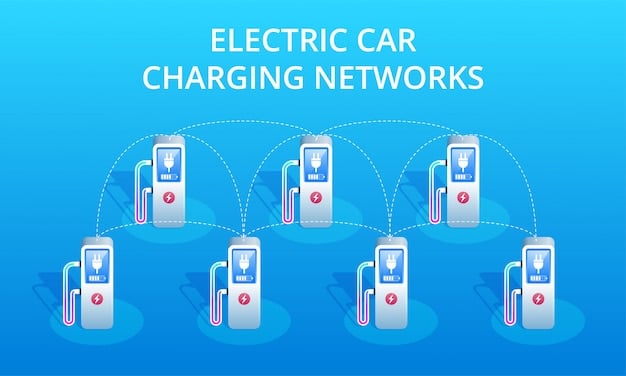
In summary, the widespread adoption of Electric Vehicle Charging Time Breakthrough: New Fast-Charging Technology Reduces Charging Time to 15 Minutes for Most Electric Vehicle Models requires careful planning and investment in infrastructure. Upgrading the grid, developing charging standards, and addressing costs are key challenges that must be overcome to realize the full potential of this technology.
The Cost Factor: Is Fast Charging Affordable?
The economic viability of 15-minute charging hinges not only on technological advancements but also on its affordability for consumers and charging infrastructure providers. The cost structure includes several components, ranging from initial setup to ongoing operational expenses, and ultimately influences the end-user price.
Initial Investment and Operational Costs
Setting up a fast-charging station involves significant capital outlay. This includes purchasing high-power charging units, upgrading grid connections, and potentially incorporating battery storage solutions to manage peak demand. Operational costs include electricity consumption, maintenance, and network management fees.
Pricing Strategies and Consumer Affordability
Charging providers adopt various pricing models, such as per-minute rates, kilowatt-hour charges, or subscription plans. The challenge is to strike a balance that incentivizes EV adoption without deterring potential users due to high costs. Government subsidies and incentives play a vital role in making fast charging economically accessible.
Long-Term Cost Benefits
Despite immediate costs, fast charging can contribute to long-term economic benefits. By reducing charging times, it can increase the turnover rate at charging stations, potentially boosting revenue. Moreover, as technology matures and economies of scale are realized, the costs associated with fast charging are expected to decline.
Thus, while the upfront and operational costs of fast charging are substantial, strategic pricing, government support, and long-term economic benefits are crucial in making it a viable and affordable option for consumers and providers. Addressing these economic factors is pivotal in accelerating the overall adoption of electric vehicles.
Future Trends and Innovations
The journey towards faster and more efficient EV charging is ongoing. Several emerging trends and innovations are poised to further enhance charging technology and improve the EV ownership experience. These include advancements in wireless charging, battery swapping, and vehicle-to-grid (V2G) technology.
Wireless Charging
Wireless charging offers a convenient and seamless way to charge EVs without the need for cables. Inductive charging pads embedded in roads or parking spaces can automatically charge EVs as they drive or park. This technology has the potential to revolutionize the way EVs are charged, making it easier and more convenient for drivers.
Battery Swapping
Battery swapping involves replacing depleted batteries with fully charged ones at specialized stations. This approach can provide a similar refueling experience to gasoline cars, with battery swaps taking just a few minutes. Battery swapping can be particularly useful for fleet vehicles and commercial applications where downtime is a concern.
Vehicle-to-Grid (V2G) Technology
V2G technology enables EVs to not only draw power from the grid but also send power back to the grid when needed. This can help stabilize the grid, reduce peak demand, and provide additional revenue streams for EV owners. V2G technology has the potential to transform EVs from passive consumers of electricity into active participants in the energy ecosystem.
- Enhanced Convenience: Wireless charging simplifies the charging process.
- Reduced Downtime: Battery swapping offers a quick alternative to charging.
- Grid Stabilization: V2G technology helps balance electricity supply and demand.
In essence, the future of Electric Vehicle Charging Time Breakthrough: New Fast-Charging Technology Reduces Charging Time to 15 Minutes for Most Electric Vehicle Models is bright, with a range of exciting innovations on the horizon. Wireless charging, battery swapping, and V2G technology have the potential to further enhance the convenience, efficiency, and sustainability of electric mobility.
| Key Point | Brief Description |
|---|---|
| ⚡ 15-Minute Charge | New tech reduces EV charging time to 15 minutes. |
| 🔋 Battery Innovation | Solid-state batteries and improved electrodes enable faster charging. |
| 🔌 Infrastructure Upgrade | More powerful charging stations needed to support rapid charging. |
| 💰 Cost Challenges | Affordability depends on pricing, subsidies, and economies of scale. |
Frequently Asked Questions
▼
The technology uses advanced battery chemistry, high-power charging stations, and enhanced thermal management to safely deliver a full charge in just 15 minutes.
▼
While designed for broad compatibility, specific EV models may require adaptations to fully utilize the 15-minute charging capability due to different battery systems.
▼
It will likely boost EV adoption by easing range anxiety, as reduced charging times make EVs more convenient for long trips, closely mimicking the refueling experience.
▼
Yes, the existing grid needs upgrades to handle higher power demands from ultra-fast chargers, as well as standardization in charging protocols.
▼
The widespread availability of 15-minute charging stations can significantly diminish range anxiety thus promoting electric car use for long journeys.
Conclusion
The advent of Electric Vehicle Charging Time Breakthrough: New Fast-Charging Technology Reduces Charging Time to 15 Minutes for Most Electric Vehicle Models marks a pivotal moment for electric mobility. With faster charging, EVs become more convenient and accessible, potentially revolutionizing the automotive industry and accelerating the transition to a sustainable transportation future.
